 |

|

|
by Peter Tyson Madagascar's wildlife is almost wholly unique to the island. You've probably heard of lemurs, but how about tenrecs? Vangas? Mesites? Have you ever seen a giraffe-necked weevil? An octopus tree? The three-cornered palm? Madagascar has lizards that scream, giant cockroaches that hiss, and trees that hold 200 gallons of water in their bloated trunks. All these and thousands more plants and animals are found only on this 1,000-mile-long island off southeast Africa. The vast majority remain little-known and under siege from forest burning, hunting, collecting for the pet trade, and other causes. On this two-part NOVA/PBS Online Adventure, we will join scientists studying two of the island's most elusive creatures: the fossa, a cat-like carnivore; and the silky sifaka, a ghostly, all-white lemur that is perilously close to extinction (fewer than 1,000 individuals are thought to survive). Between May 18 and June 8, we will visit two radically different ecosystems in northern Madagascar to track down these fascinating mammals.
In the first half of the three-week journey, we'll enter the otherworldly landscape of the Ankarana reserve (see map). A spectacularly eroded limestone massif rising out of an arid savanna running alongside the Mozambique Channel, the Ankarana ("an-kar-ana") is topped by razor-sharp rock formations called tsingy. Named for the hollow sound they make when struck, the all-but-impassable tsingy collectively look like a stormy sea frozen in stone. The massif also bears deep, forest-filled canyons, more than 60 miles of cave passages, and underground rivers that lead to miniature lost worlds where the cave roof has collapsed and pockets of deciduous forest have grown up, complete with species all their own. In this unusual land, we'll join Luke Dollar, a young ecologist at the University of Tennessee. A former child actor, Dollar is fast becoming the leading expert on the carnivores of Madagascar (see Get Real). In the canyons, whose sheer walls rise up to 900 feet over the surrounding plain, he will trap and radiocollar the fossa (pronounced "FOO-sa") and other endemic meat-eaters. Like a cross between a puma and a mongoose, with a tail fully as long as its body, the fossa is a viverid, an ancient line of carnivore that predates the felines and canines (the cat and dog families). Crytoprocta ferox, as scientists know it, is aptly named, for to its victims the fossa is truly ferocious. Sleek and rangy with a musky odor tinged with that of rotting flesh, the fossa is the quintessence of feral, and its powerful jaws and retractile claws have spelled doom for many an unwary lemur.
In the Ankarana, we will also search for crocs within the caverns, some of which tower 500 feet overhead, and down rivers that flow out of the caves and into mangrove forests on the edge of the Mozambique Channel. Again, the goal is better understanding and preservation of an animal so reviled throughout Madagascar that the few that have survived hunting and wanton killing have been forced to retreat into the Ankarana caves, where they have gained distinction as the world's only cave-living crocodiles.
In the second half of the expedition, the NOVA film and online crews will journey onto a massif that could hardly be more different than the one we will have just left. The Ankarana is arid, lies at sea level, and bears dry tropical forest. While only about 100 miles away as the crow flies, Marojejy ("mar-oo-dzedz") is one of the wettest places in Madagascar, rises to over 7,000 feet, and features dense tropical rain forest. While the Ankarana attracts the occasional Western and Malagasy travelers, the extremely remote Marojejy Special Reserve, which we'll visit (see map), is off-limits to all save qualified researchers. The local Betsimisaraka people say these largely unexplored hills are home to the kalonoro or "wild people" (see Malagasy Legends). But no one really knows, because only a handful of scientists have journeyed into this region, and much of its wildlife is either unknown or barely studied. The silky sifaka ("she-fahk") is a case in point. One of the largest living lemurs, Propithecus diadema candidus has bushy white fur, a long white tail, and ghostly eyes. No one has ever thoroughly studied it, and there are no silky sifakas living in captivity. It has been observed in recent years only in the roughly 150,000-acre Marojejy Special Reserve and in another reserve to the south, and as such conservation authorities have labeled it "critically endangered." Our team will meet up with Dr. Patricia Wright, a primatologist at the State University of New York at Stonybrook. Bearing a quick, broad smile and slightly Oriental eyes, Wright is easygoing and motherly, but those characteristics mask a formidable drive. She is almost singlehandedly responsible for the formation of Madagascar's fourth national park, Ranomafana, for which, along with her research on another diademed sifaka called Milne-Edwards' sifaka, she earned a MacArthur "genius grant" and was knighted by the Malagasy government.
Through regular dispatches from the field, follow this exciting journey into two of the most inaccessible and species-rich sites on Madagascar, an island that has been called "the naturalist's promised land." Peter Tyson is Online Producer of NOVA. Photos: (1,3) Roy Toft; (2) David Parks; (4) Peter Tyson; (5) David Lowe. The Expedition | Surviving The Wilds | Explore Madagascar Dispatches | Classroom Resources | E-Mail | Resources Site Map | The Wilds of Madagascar Home Editor's Picks | Previous Sites | Join Us/E-mail | TV/Web Schedule About NOVA | Teachers | Site Map | Shop | Jobs | Search | To print PBS Online | NOVA Online | WGBH © | Updated November 2000 |
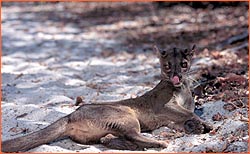 Sleek, elusive, and preternaturally feral, a fossa ("FOO-sa") lounges in the Ankarafantsika Reserve.
Sleek, elusive, and preternaturally feral, a fossa ("FOO-sa") lounges in the Ankarafantsika Reserve.
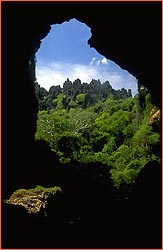 Looking out from a cave in the Ankarana massif onto a lost forest and, beyond, the tsingy.
Looking out from a cave in the Ankarana massif onto a lost forest and, beyond, the tsingy.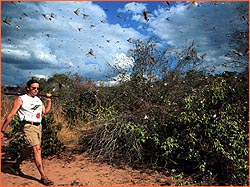 Amid a cloud of locusts, Luke Dollar heads out to search for the fossa in the scorchingly hot savannas of western Madagascar.
Amid a cloud of locusts, Luke Dollar heads out to search for the fossa in the scorchingly hot savannas of western Madagascar.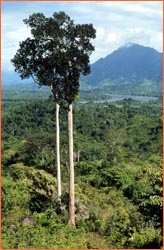 A distant view of the largely unexplored Marojejy massif.
A distant view of the largely unexplored Marojejy massif.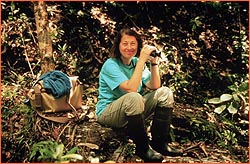 Pat Wright in her element: studying Milne-Edwards' sifakas within Ranomafana National Park.
Pat Wright in her element: studying Milne-Edwards' sifakas within Ranomafana National Park.